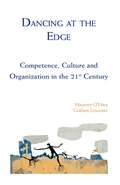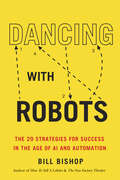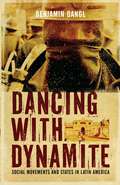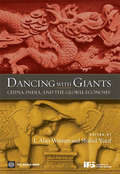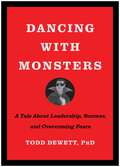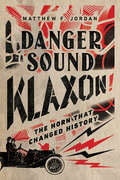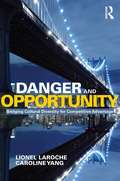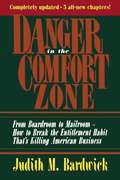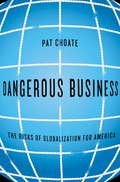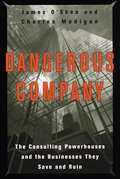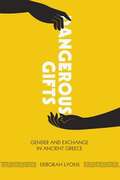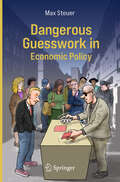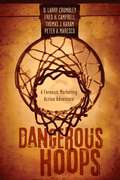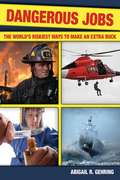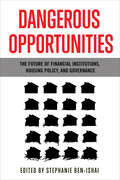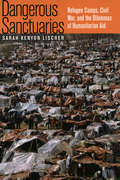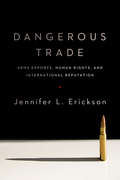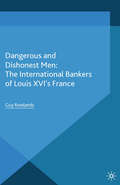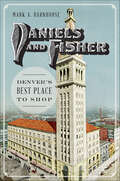- Table View
- List View
Dances with Dependency: Out of Poverty Through Self-Reliance
by Calvin HelinDances with Dependency offers effective strategies to eliminate welfare dependency and help eradicate poverty among indigenous populations. Beginning with an impassioned and insightful portrait of today&’s native communities, it connects the prevailing impoverishment and despair directly to a &“dependency mindset&” forged by welfare economics. To reframe this debilitating mindset, it advocates policy reform in conjunction with a return to native peoples&’ ten-thousand-year tradition of self-reliance based on personal responsibility and cultural awareness. Author Calvin Helin, un-tethered to agendas of political correctness or partisan politics, describes the mounting crisis as an impending demographic tsunami threatening both the United States and Canada. In the United States, where government entitlement programs for diverse ethnic minorities coexist with an already huge national debt, he shows how prosperity is obviously at stake. This looming demographic tidal wave viewed constructively, however, can become an opportunity for reform—among not only indigenous peoples of North America but any impoverished population struggling with dependency in inner cities, developing nations, and post-totalitarian countries.
Dancing At The Edge: Competence, Culture And Organization In The 21st Century
by Maureen O'Hara Jennifer Williams Graham LeicesterIn his 1980 essay, The World of Tomorrow and the Person of Tomorrow, the psychologist Carl Rogers contemplated the future. He described those who would usher in this new era as people with the capacity to understand, bring about and absorb a paradigm shift. He added: "I have an uneasy feeling about this chapter... It is a beginning, an outline, a suggestion... I believe that what I am saying here will some day be fleshed out much more fully, either by me or someone else." Maureen O'Hara and Graham Leicester are uniquely qualified fleshers-out. They draw on their own extensive research and practical experience observing some of today's most successful cultural, political and business leaders to explore the competencies that can best help us navigate the 'blooming, buzzing confusion' of the 21st century. They conclude that these are innate and within reach of all of us - given the right setting, plenty of practice and some gentle guidance. But they are seldom seen because they are routinely undervalued in today's culture. That must change, the authors insist, and this book is intended to begin that change. Theodore Hesburgh, President Emeritus of Notre Dame University, once said that leadership demands certainty: "You cannot blow an uncertain trumpet." On the contrary, argue Leicester and O'Hara, we must all learn to play the uncertain trumpet like virtuosos. It is an image that conveys the subtle discipline required of 'persons of tomorrow.' "They are the people already among us who inhabit the complex and messy problems of the 21st century in a more expansive way than their colleagues... They dance at the edge."
Dancing Through Complexity: Shaping Resolutions by Resisting Simplification
by Roger L. MartinThis chapter identifies how the twin forces of simplification and specialization-hallmarks of modern life and business-discourage integrative thinking, and describes how these forces can be countered.
Dancing With Robots: The 29 Strategies for Success In the Age of AI and Automation
by Bill BishopSurvive and thrive in a world being taken over by robots and other advanced technology. Artificial intelligence, machine learning, algorithms, blockchains, the Internet of Things, big data analytics, 5G networks, self-driving cars, robotics, 3D printing. In the coming years, these technologies, and others to follow, will have a profound and dramatically disruptive impact on how we work and live. Whether we like it or not, we need to develop a good working relationship with these technologies. We need to know how to “dance” with robots. In Dancing with Robots, futurist, entrepreneur, and innovation coach Bill Bishop describes 29 strategies for success in the New Economy. These new strategies represent a bold, exciting, unexpected, and radically different road map for future success.Bishop also explains how our Five Human Superpowers — embodied pattern recognition, unbridled curiosity, purpose-driven ideation, ethical framing, and metaphoric communication — give us a competitive edge over robots and other advanced technology in a world being taken over by automation and AI.
Dancing with Dynamite
by Benjamin DanglGrassroots social movements played a major role electing left-leaning governments throughout Latin America. Subsequent relations between these states and "the streets" remain troubled. Contextualizing recent developments historically, Dangl untangles the contradictions of state-focused social change, providing lessons for activists everywhere.
Dancing with Giants: China, India, and the Global Economy
by Shahid Yusuf Alan WintersChina is now the world's fourth largest economy and growing very fast. India's economic salience is also on the rise. Together these two countries will profoundly influence the pace and nature of global economic change. Drawing upon the latest research, this volume analyzes the influences on the rapid future development of these two countries and examines how their growth is likely to impinge upon other countries. It considers international trade, industrialization, foreign investment and capital flows, and the implications of their broadening environmental footprints. It also discusses how the two countries have tackled poverty, inequality and governance issues and whether progress in these areas will be a key to rapid and stable growth.
Dancing with Monsters: A Tale About Leadership, Success, and Overcoming Fears
by Todd DewettIs fear limiting your leadership potential? Dancing with Monsters will inspire you to overcome your fears and optimize your key relationships by leveraging humility, authenticity, and kindness. Fears and discomfort slow us down and sometimes completely derail our personal progress. As leaders at work, we can similarly be knocked off course by the conflict, personality differences, motivational issues, and performance problems within our teams. These obstacles are the monsters in our lives. In Dancing with Monsters, globally recognized leadership educator, author, and speaker Todd Dewett, PhD, offers an enthralling, fast-paced fable that examines how to embrace those monsters in order to harness you and your team&’s true power. Joe is a depressed vampire at risk of losing his monster status due to poor performance. He is tasked with leading a group of misfit monsters who lack confidence. Sheets, Mum, Wolfy, and Z have not yet learned to do the one thing all monsters do: scare kids. Dancing with Monsters tells the story of their collective efforts, missteps included, toward connecting with their authentic selves. This captivating story plus Dewett&’s discussion and reflection prompts add up to a must-read guide to reclaiming your better self by learning to dance with your monsters.
Danger Sound Klaxon!: The Horn That Changed History
by Matthew F. JordanDanger Sound Klaxon! reveals the untold story of the Klaxon automobile horn, one of the first great electrical consumer technologies of the twentieth century. Although its metallic shriek at first shocked pedestrians, savvy advertising strategies convinced consumers across the United States and western Europe to adopt the shrill Klaxon horn as the safest signaling technology available in the 1910s. The widespread use of Klaxons in the trenches of World War I, however, transformed how veterans heard this car horn, and its traumatic association with gas attacks ultimately doomed this once ubiquitous consumer technology.By charting the meteoric rise and eventual fall of the Klaxon, Matthew Jordan highlights how perceptions of sound-producing technologies are guided by, manipulated, and transformed through advertising strategies, public debate, consumer reactions, and governmental regulations. Jordan demonstrates in this fascinating history how consumers are led toward technological solutions for problems themselves created by technology.
Danger and Opportunity: Bridging Cultural Diversity for Competitive Advantage
by Lionel Laroche Caroline YangThe Chinese characters for "danger" and "opportunity" form the word "crisis". Ancient Chinese wisdom sees an opportunity in danger. While cultural diversity brings challenges to the workplace, how do we turn these challenges into opportunities? Drawing on their extensive experience working with multicultural and multinational organizations, Lionel Laroche and Caroline Yang provide an in-depth analysis of cross-cultural dynamics in the workplace and offer practical suggestions at both the individual and organizational levels. The book analyzes cross-cultural challenges in six areas: the relative importance of technical and soft skills; cross-cultural communication; cross-cultural feedback; hierarchy; individualism; and risk tolerance. It then provides a solutions framework that encompasses people, systems and environment to bridge the issues that arise from cultural differences. The analysis and solutions are applied in four business contexts: managing a multicultural workforce; competing in the global talent market; collaborating with joint venture partners; and working with offshore resources. If you work with colleagues, managers, employees and customers from diverse cultures, if you are with an organization that has a multicultural workforce and/or global operations, or if your organization collaborates with joint venture partners or offshore resources from different cultures, then Danger and Opportunity: Bridging Cultural Diversity for Competitive Advantage is the book for you.
Danger in the Comfort Zone: From Boardroom to Mailroom -- How to Break the Entitlement Habit That's Killing American Business
by Judith M. BardwickDanger in the Comfort Zone examines the phenomenon of the "entitlement" mentality in the American workforce -- people's preoccupation with their rewards rather than their responsibilities. Bardwick describes three basic mindsets and shows the effect of each on individuals and their organizations: * Entitlement -- people feel entitled to rewards and lethargic about having to earn them; motivation and job satisfaction are low * Fear -- people are paralyzed; the threat of layoffs makes them focus on protecting their jobs rather than doing them well * Earning -- people are energized by challenge; they know their accomplishments will be noticed -- and rewarded In this paperback edition, Bardwick points out that although the "fear" element has undoubtedly grown in the last few years, the entitlement attitude is still firmly entrenched at all levels. She offers additional chapters with new, specific techniques for pulling people out of the quagmire of fear and complacency, and igniting them with the energy of true earning.
Dangerous Business: The Risks of Globalization for America
by Pat ChoateFrom one of the most respected and vigorous economic thinkers in Washington, a wake-up call about the perils of unfettered globalization. In this impassioned, prescient book, Pat Choate shows us that while increased worldwide economic integration has some benefits for our fiscal efficiency, it also creates dependencies, vulnerabilities, national security risks, and social costs that now outweigh its advantages. He takes the long view of developments such as technology-driven progress, the offshoring of jobs, and open trade, arguing that current U.S. policies are leading to worldwide economic and political instability, in much the same way as before the Great Depression.Choate writes convincingly about the Defense Department&’s growing dependence on foreign sources for its technologies, the leasing of parts of our interstate highway system to overseas investors, China&’s economic mercantilism, and international currency manipulation that damages the dollar. We have been borrowing heavily from foreign lenders, who by 2009 will own more than half of the Treasury debt, a third of U.S. corporate bonds, and a sixth of U.S. corporate assets—all of which, if handled improperly, could trigger a global economic collapse.But our economic forecast need not be dire. Choate sees a way out of these dilemmas and presents politically viable steps the United States can take to remain sovereign, prosperous, and secure. He presents bold new research that identifies the special interests and structural corruption that have overtaken our democracy—and shows how they can be corrected. He illustrates how our policy-making and legislative process, currently beholden to the highest bidder, can be transformed from one of corporatism and elitism into one of greater transparency. Clear-eyed and persuasive, this is sure to be one of the most widely discussed books of the year.
Dangerous Company: The Consulting Powerhouses and the Businesses They Save and Ruin
by Charles MadiganDangerous Company chronicles the successes, failures, and practices of the biggest and most influential firms in the consulting industry. O'Shea and Madigan chronicle such stories as the one involving the consultant who provided state's evidence and landed his client behind bars, the Fortune 500 company that was billed over $75 million in consulting fees yet was left on the brink of bankruptcy, and the role played by consultants in the rejuvenation of Sears.From the Hardcover edition.
Dangerous Gifts: Gender and Exchange in Ancient Greece
by Deborah LyonsDeianeira sends her husband Herakles a poisoned robe. Eriphyle trades the life of her husband Amphiaraos for a golden necklace. Atreus’s wife Aerope gives away the token of his sovereignty, a lamb with a golden fleece, to his brother Thyestes, who has seduced her. Gifts and exchanges always involve a certain risk in any culture, but in the ancient Greek imagination, women and gifts appear to be a particularly deadly combination. This book explores the role of gender in exchange as represented in ancient Greek culture, including Homeric epic and tragedy, non-literary texts, and iconographic and historical evidence of various kinds. Using extensive insights from anthropological work on marriage, kinship, and exchange, as well as ethnographic parallels from other traditional societies, Deborah Lyons probes the gendered division of labor among both gods and mortals, the role of marriage (and its failure) in transforming women from objects to agents of exchange, the equivocal nature of women as exchange-partners, and the importance of the sister-brother bond in understanding the economic and social place of women in ancient Greece. Her findings not only enlarge our understanding of social attitudes and practices in Greek antiquity but also demonstrate the applicability of ethnographic techniques and anthropological theory to the study of ancient societies.
Dangerous Guesswork In Economic Policy
by Max SteuerThis book highlights the importance of economic knowledge in government decision-making. Almost every decision and responsibility facing governments involves economic considerations as well as other aspects. Whether it is funding the military, management of the health care system, or taxing appropriately, the issues are too complex and too important to be left to hunch, intuition, and guesswork. A politician who aspires to more than personal power, and wants to benefit the national society, needs good economic advice. Recognizing the need for effective advice and knowing how to find it is itself challenging. This book points the way. A sophisticated overview of economics is the key and a realistic attainment. How does economics work? Is it science? Is it common sense dressed up in jargon? This book provides insight into what is going on in the discipline and why this knowledge is needed. Students intending to study economics can get a head start from this book. Those alreadyengaged can be helped around some awkward corners. The main audience is the general reader. Economic turmoil abounds. Does it look like informed policies are being undertaken? Does the discussion on radio and other media of current problems have the feel and thrust of genuine knowledge, or is it merely spinning out familiar cliches and guesses? Reading this book, the concerned citizen, the reader with curiosity, and the informed voter will enjoy knowing more about effective economic policy.
Dangerous Hoops: A Forensic Marketing Action Adventure
by D. Larry Crumbley Fred H. Campbell Thomas J. Karam Peter A. MarescoPart crime novel, part textbook, Dangerous Hoops combines the principles of marketing and forensic accounting into a lively narrative to educate and entertain. Set in the world of professional sports, Dangerous Hoops introduces FBI agent Bill Douglass as he pursues a deadly extortionist in order to save lives -- and spare the NBA from a public relations nightmare. The adventurous storyline -- complete with demands for cash and diamonds, poisoned collectors' cards, and botched drop-offs -- also explores aspects of business and marketing with examples from the world of pro basketball. Both innovative and educational, Dangerous Hoops provides real instruction in a novel form and serves as a refreshing text for business majors and MBA students.
Dangerous Jobs: The Adventurer's Guide to High-Risk Careers
by Abigail R. GehringThe success of A&E's hit series "Deadliest Catch" and Discovery Channel's new reality show, "The World's Toughest Jobs" prove that Americans are fascinated with danger and the people who make it their livelihood. Here readers will find all the harrying details on dozens of the riskiest jobs on earth. Ever thought about becoming a bounty hunter? Wondered how much bullfighters make? Considered training lions or jumping out of helicopters into forest fires for some extra cash? Did you know truck drivers have steered themselves into one of the most dangerous jobs in America? Dangerous Jobs offers an entertaining and informational guide to employment for the truly adventurous soul.
Dangerous Opportunities: The Future of Financial Institutions, Housing Policy, and Governance
by Stephanie Ben-IshaiThe 2017 Home Capital saga represents the shortcomings of a financial system challenged by distinct, siloed regulatory frameworks that fail to communicate with each other. Home Capital is a publicly traded company that acts as a lender through the Home Trust Company, most often providing mortgages to clients rejected by traditional banks. Home Capital’s 2017 announcement that it required $2 billion to sustain a $600 million loss shook customer confidence, and fueled by allegations of corruption, they suffered a rapid decline in stock price. The Home Capital crisis is the most recent pre-pandemic example of systemic risk in the financial sector in Canada and highlights the invaluable opportunity that we have in avoiding past mistakes in the nearing post-pandemic economic reality. Dangerous Opportunities sheds light, using the 2017 Home Capital saga as a starting point, on the compartmentalization of regulators and its greater ramifications on board independence and corporate governance, taxation in the competitive house context, and non-bank financial institutions’ success in various jurisdictions. A hybrid of law and business, Dangerous Opportunities is a must read for those interested in the underbelly of financial institutions, and is an inspired read in the aftermath of the recent housing crisis which saw many desiring-homeowners seeking dangerous opportunities outside of the traditional banking system.
Dangerous Sanctuaries: Refugee Camps, Civil War, and the Dilemmas of Humanitarian Aid
by Sarah Kenyon LischerSince the early 1990s, refugee crises in the Balkans, Central Africa, the Middle East, and West Africa have led to the international spread of civil war. In Central Africa alone, more than three million people have died in wars fueled, at least in part, by internationally supported refugee populations. The recurring pattern of violent refugee crises prompts the following questions: Under what conditions do refugee crises lead to the spread of civil war across borders? How can refugee relief organizations respond when militants use humanitarian assistance as a tool of war? What government actions can prevent or reduce conflict? To understand the role of refugees in the spread of conflict, Sarah Kenyon Lischer systematically compares violent and nonviolent crises involving Afghan, Bosnian, and Rwandan refugees. Lischer argues against the conventional socioeconomic explanations for refugee-related violence--abysmal living conditions, proximity to the homeland, and the presence of large numbers of bored young men. Lischer instead focuses on the often-ignored political context of the refugee crisis. She suggests that three factors are crucial: the level of the refugees' political cohesion before exile, the ability and willingness of the host state to prevent military activity, and the contribution, by aid agencies and outside parties, of resources that exacerbate conflict. Lischer's political explanation leads to policy prescriptions that are sure to be controversial: using private security forces in refugee camps or closing certain camps altogether. With no end in sight to the brutal wars that create refugee crises, Dangerous Sanctuaries is vital reading for anyone concerned with how refugee flows affect the dynamics of conflicts around the world.
Dangerous Trade
by Jennifer EricksonIn 2013, the United Nations approved the Arms Trade Treaty (ATT), which sets legally binding standards to regulate global arms exports. This groundbreaking treaty reflects a growing concern that small and major conventional arms play a significant role in perpetuating human rights violations, conflict, and societal instability worldwide. While many countries once staunchly opposed shared export controls and their perceived threat to political and economic autonomy, they are now beginning to embrace numerous agreements, such as the ATT and the EU Code of Conduct.Jennifer L. Erickson explores the reasons top arms-exporting democracies have put aside past sovereignty, security, and economic worries in favor of humanitarian arms transfer controls, and she follows the early effects of this about-face on export practice. She begins with a brief history of failed modern arms-export control initiatives and then tracks arms transfer trends over time. Pinpointing the normative shifts in the 1990s that put humanitarian arms control on the table, she reveals that these states committed to these policies out of concern for their international reputations. She also highlights how arms-trade scandals threaten domestic reputations and thus help improve compliance. Using statistical data and interviews conducted in France, Germany, Belgium, the United Kingdom, and the United States, Erickson challenges existing IR theories of state behavior, while providing insight into the role of reputation as a social mechanism and the importance of government transparency and accountability in generating compliance with new norms and rules.
Dangerous Trade: Arms Exports, Human Rights, and International Reputation
by Jennifer EricksonThe United Nations's groundbreaking Arms Trade Treaty (ATT), which went into effect in 2014, sets legally binding standards to regulate global arms exports and reflects the growing concerns toward the significant role that small and major conventional arms play in perpetuating human rights violations, conflict, and societal instability worldwide. Many countries that once staunchly opposed shared export controls and their perceived threat to political and economic autonomy are now beginning to embrace numerous agreements, such as the ATT and the EU Code of Conduct. Jennifer L. Erickson explores the reasons top arms-exporting democracies have put aside past sovereignty, security, and economic worries in favor of humanitarian arms transfer controls, and she follows the early effects of this about-face on export practice. She begins with a brief history of failed arms export control initiatives and then tracks arms transfer trends over time. Pinpointing the normative shifts in the 1990s that put humanitarian arms control on the table, she reveals that these states committed to these policies out of concern for their international reputations. She also highlights how arms trade scandals threaten domestic reputations and thus help improve compliance. Using statistical data and interviews conducted in France, Germany, Belgium, the United Kingdom, and the United States, Erickson challenges existing IR theories of state behavior while providing insight into the role of reputation as a social mechanism and the importance of government transparency and accountability in generating compliance with new norms and rules.
Dangerous and Dishonest Men: The International Bankers Of Louis Xiv's France (Palgrave Studies in the History of Finance)
by G. RowlandsAt the start of the eighteenth century Louis XIV needed to remit huge sums of money abroad to support his armies during the War of the Spanish Succession. This book explains how international bankers moved French money across Europe, and how the foreign exchange system was so overloaded by the demands of war that a massive banking crash resulted.
Daniel Dobbins Distillery, Inc.
by William J. Bruns Jr.A distiller increases whiskey production and income declines because of accounting methods in use. Questions are raised regarding the treatment of expenditures which can be classified as production, inventory, or period costs. The necessary aging process raises added questions about prior period restatements and needed financing. A rewritten version of an earlier case by R.F. Vancil and R.H. Deming.
Danielle Marcoux at AdNet2Win Technologies
by Anthony J. Mayo Joshua D. MargolisDanielle Marcoux, Director of Web Design at AdNet2Win Technologies, must decide how best to confront Charles Davide, the Chief Technology Officer and leader of the design team charged with overseeing a major upgrade of the company's proprietary customer loyalty platform. Davide has kept tight control on the development process and has not allowed the design team to discuss difficult issues or challenge each other. Marcoux decides she must confront Davide about his management approach before the team loses their commitment to the design effort.
Daniels and Fisher: Denver's Best Place to Shop
by Mark BarnhouseFor 129 years, Daniels and Fisher and May-D&F proudly served the Mile High City. Today, the restored Daniels and Fisher Tower adorns the Sixteenth Street Mall while the I.M. Pei-designed ice-skating rink and hyperbolic paraboloid at May-D&F survive only in memories. The story of these institutions is filled with fascinating characters, including dashing, tower-building William Cooke Daniels; his aristocratic English wife, Cicely; and flamboyant William Zeckendorf, whose city-building dreams outpaced his finances. Generations of Denverites shopped these stores and still remember white-gloved sales ladies, meals served in the D&F Tea Room and views from the observation deck. Join author Mark A. Barnhouse as he brings the spectacular Christmas displays, fantastic fortnights celebrating foreign cultures and Carl Sandell--the seven-foot, five-inch Daniels and Fisher doorman--back to life.

